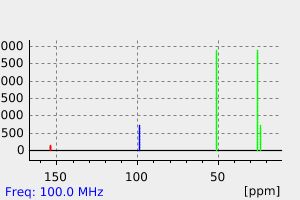1-[3,5-二(哌啶-1-基)苯基]哌啶 | 16857-95-7
中文名称
1-[3,5-二(哌啶-1-基)苯基]哌啶
中文别名
——
英文名称
1,3,5-tripiperidinobenzene
英文别名
1,1',1''-benzene-1,3,5-triyltripiperidine;1,3,5-tris(1-piperidinyl)benzene;1,3,5-tris(N-piperidinyl)benzene;1,3,5-tripiperidin-1-ylbenzene;1,3,5-tris(1-piperidyl)benzene;1,3,5-tris(N-piperidyl)benzene;1-[3,5-di(piperidin-1-yl)phenyl]piperidine
CAS
16857-95-7
化学式
C21H33N3
mdl
——
分子量
327.513
InChiKey
VYSPTRONAFCTMA-UHFFFAOYSA-N
BEILSTEIN
——
EINECS
——
-
物化性质
-
计算性质
-
ADMET
-
安全信息
-
SDS
-
制备方法与用途
-
上下游信息
-
文献信息
-
表征谱图
-
同类化合物
-
相关功能分类
-
相关结构分类
物化性质
-
熔点:178-181 °C(Solv: acetone (67-64-1))
-
沸点:519.9±45.0 °C(Predicted)
-
密度:1.069±0.06 g/cm3(Predicted)
计算性质
-
辛醇/水分配系数(LogP):4.8
-
重原子数:24
-
可旋转键数:3
-
环数:4.0
-
sp3杂化的碳原子比例:0.71
-
拓扑面积:9.7
-
氢给体数:0
-
氢受体数:3
上下游信息
-
上游原料
中文名称 英文名称 CAS号 化学式 分子量 —— 1,3,5-tris(N-pyrrolidinyl)benzene 16857-93-5 C18H27N3 285.432 1-[2-碘-3,5-二(哌啶-1-基)苯基]哌啶 2,4,6-Tripiperidinoiodobenzene 87350-81-0 C21H32IN3 453.41 -
下游产品
中文名称 英文名称 CAS号 化学式 分子量 1-[2-碘-3,5-二(哌啶-1-基)苯基]哌啶 2,4,6-Tripiperidinoiodobenzene 87350-81-0 C21H32IN3 453.41 —— 1,3,5-trimorpholinobenzene 16857-97-9 C18H27N3O3 333.431
反应信息
-
作为反应物:描述:参考文献:名称:Synthesis, structure, and spectral behavior of donor-acceptor substituted biphenyls摘要:DOI:10.1021/jo00172a040
-
作为产物:描述:1-(4-(bis(4-(methyl(2,2,2-trifluoroethyl)amino)phenyl)methyl)-3,5-di(pyrrolidin-1-yl)cyclohexa-2,5-dien-1-ylidene)pyrrolidin-1-ium tetrafluoroborate 以 二氯甲烷 、 氘代乙腈 为溶剂, 生成 1-[3,5-二(哌啶-1-基)苯基]哌啶参考文献:名称:1,3,5-三(二烷基氨基)苯的路易斯碱度和亲核性的量化摘要:3xy形成的平衡常数已通过光度测定法确定。环碳趋势的路易斯碱度为:三吗啉代苯1a <三哌啶基苯1b <三吡咯烷基苯1c;亲核性参数在 10< N <15的范围内。由于在环的不同位置发生快速逆反应和重组,一些配合物显示出温度依赖性 NMR 光谱。DFT 计算与实验数据一致。DOI:10.1002/ejoc.202100939
文献信息
-
Nickel-catalysed sequential amination of aryl- and heteroaryl di- and trichlorides作者:Christophe Desmarets、Raphaël Schneider、Yves FortDOI:10.1016/s0040-4020(01)00730-x日期:2001.9Unsymmetrical 1,3-diaminobenzenes and diaminopyridines were efficiently prepared by reaction of 3-chloroanilines and chloroaminopyridines with amines via a nickel-catalysed amination. The Ni/2,2′-bipyridine catalyst is also effective for the sequential amination of aryl trichlorides. After a first selective monoamination of 1,3,5-trichlorobenzene, the obtained 3,5-dichloroanilines were subsequently transformed
-
Unusual Reactions Between Aromatic Carbon Supernucleophiles and 1,2-Diazabuta-1,3-dienes: Useful Routes to New Pyrazolone and Cinnoline Derivatives作者:Luciano Forlani、Orazio A. Attanasi、Carla Boga、Lucia De Crescentini、Erminia Del Vecchio、Gianfranco Favi、Fabio Mantellini、Silvia Tozzi、Nicola ZannaDOI:10.1002/ejoc.200800445日期:2008.9Reactions between 1,3,5-tris(dialkylamino)benzenes and 1,2-diazabuta-1,3-dienes produce semicarbazone derivatives through attack of the supernucleophile aromatic carbon atom at the terminal carbon atom of the heterodiene reagent. The strong activation of the aromatic ring due to the presence of the three amino groups in a symmetrical relationship promotes electrophilic aromatic substitution by the neutral
-
Palladium-Catalyzed Selective Amination of Haloaromatics on KF-Alumina Surface作者:Basudeb Basu、Pralay Das、Ashish Nanda、Sajal Das、Sajal SarkarDOI:10.1055/s-2005-865241日期:——An efficient palladium-catalyzed amination, including polyaminations of aromatic bromides mediated on a surface of KF-alumina, is reported. The solvent-free one-pot protocol avoids the use of a strong base (sodium tert-butoxide) making it applicable to substrates containing a base-sensitive functional group. It proceeds without concomitant reductive bromination and provides access to selective amination of polyhaloaromatics.
-
Highly conjugated architectures and labile reaction intermediates from coupling between 10π electron-deficient heteroaromatics and<i>sym</i>-trihydroxy- or triamino-benzene derivatives作者:Gabriele Micheletti、Carla Boga、Silvia Cino、Silvia Bordoni、Elena ChugunovaDOI:10.1039/c8ra09460h日期:——(WM) zwitterionic intermediates, intercepted and fully characterized via NMR at low temperature, whereas stable Meisenheimer complexes (M) were isolated in the reaction of phloroglucinol with 1,3,5-trimethoxybenzene. The latter also gave exclusively M complexes when reacted with 4,6-dinitrobenzofuroxan (DNBF), or 4,6-dinitrotetrazolopyridine (DNTP). The detection of WM or M intermediates can be rationalized中性芳香碳亲核试剂(如 1,3,5-三氨基苯衍生物和 1,3,5-三羟基苯衍生物)与 7-氯-4,6-二硝基苯并呋喃 ( Cl-DNBF ) 或 7- 之间的 C-C 偶联反应氯-4,6-二硝基苯并呋喃( Cl-DNBZ )以高产率给出了相应的共轭结构,这在材料领域具有潜在的意义。当亲电子试剂上不存在氯时,如 4,6-二硝基苯并呋喃 ( DNBZ ),与 1,3,5-三氨基苯衍生物的反应会产生 Wheland-Meisenheimer ( WM ) 两性离子中间体,在低温下通过NMR 进行截取和充分表征,而稳定的 Meisenheimer 配合物 ( M ) 在间苯三酚与 1,3,5-三甲氧基苯的反应中分离出来。当与 4,6-二硝基苯并呋喃 ( DNBF ) 或 4,6-二硝基四唑吡啶 ( DNTP ) 反应时,后者也仅产生M配合物。 WM或M中间体的检测可以通过调用WM中间体中正电荷的取代基稳定能力来合理化,从中性碳亲核试剂
-
Synthesis of 2,3-Dihydroindoles, Indoles, and Anilines by Transition Metal-Free Amination of Aryl Chlorides作者:Matthias Beller、Claudia Breindl、Thomas H. Riermeier、Annegret TillackDOI:10.1021/jo001544m日期:2001.2.1and 3-chlorostyrene in the presence of potassium tert-butoxide to give N-substituted 2,3-dihydroindoles in good yields. The combination of this domino-amination protocol with a suitable dehydrogenation reaction gives access to pharmacologically interesting indoles in a one-pot procedure. Overall product yields of N-substituted indoles >50% are obtained by this method starting from commercially available
表征谱图
-
氢谱1HNMR
-
质谱MS
-
碳谱13CNMR
-
红外IR
-
拉曼Raman
-
峰位数据
-
峰位匹配
-
表征信息
同类化合物
(R)-3-甲基哌啶盐酸盐;
(R)-2-苄基哌啶-1-羧酸叔丁酯
((3S,4R)-3-氨基-4-羟基哌啶-1-基)(2-(1-(环丙基甲基)-1H-吲哚-2-基)-7-甲氧基-1-甲基-1H-苯并[d]咪唑-5-基)甲酮盐酸盐
高氯酸哌啶
高托品酮肟
马来酸帕罗西汀
颜料红48:4
顺式3-氟哌啶-4-醇盐酸盐
顺式2,6-二甲基哌啶-4-酮
顺式1-苄基-4-甲基-3-甲氨基-哌啶
顺式-叔丁基4-羟基-3-甲基哌啶-1-羧酸酯
顺式-6-甲基-哌啶-1,3-二甲酸1-叔丁酯
顺式-5-(三氟甲基)哌啶-3-羧酸甲酯盐酸盐
顺式-4-叔丁基-2-甲基哌啶
顺式-4-Boc-氨基哌啶-3-甲酸甲酯
顺式-4-(氮杂环丁烷-1-基)-3-氟哌
顺式-3-顺式-4-氨基哌啶
顺式-3-甲氧基-4-氨基哌啶
顺式-3-BOC-3,7-二氮杂双环[4.2.0]辛烷
顺式-3-(1-吡咯烷基)环丁腈
顺式-3,5-哌啶二羧酸
顺式-3,4-二溴-3-甲基吡咯烷盐酸盐
顺式-2,6-二甲基-4-氧代哌啶-1-羧酸叔丁基酯
顺式-1-叔丁氧羰基-4-甲基氨基-3-羟基哌啶
顺式-1-boc-3,4-二氨基哌啶
顺式-1-(4-叔丁基环己基)-4-苯基-4-哌啶腈
顺式-1,3-二甲基-4-乙炔基-6-苯基-3,4-哌啶二醇
顺-4-(4-氟苯基)-1-(4-异丙基环己基)-4-哌啶羧酸
顺-4-(2-氟苯基)-1-(4-异丙基环己基)-4-哌啶羧酸
顺-3-氨基-4-氟哌啶-1-羧酸叔丁酯
顺-1-苄基-4-甲基哌啶-3-氨基酸甲酯盐酸盐
非莫西汀
雷芬那辛
雷拉地尔
阿维巴坦中间体4
阿格列汀杂质
阿尼利定盐酸盐 CII
阿尼利定
阿塔匹酮
阿哌沙班杂质BMS-591455
阿哌沙班杂质87
阿哌沙班杂质52
阿哌沙班杂质51
阿哌沙班杂质5
阿哌沙班杂质
阿哌沙班杂质
阿哌沙班-d3
阿哌沙班
阻聚剂701
间氨基谷氨酰胺







